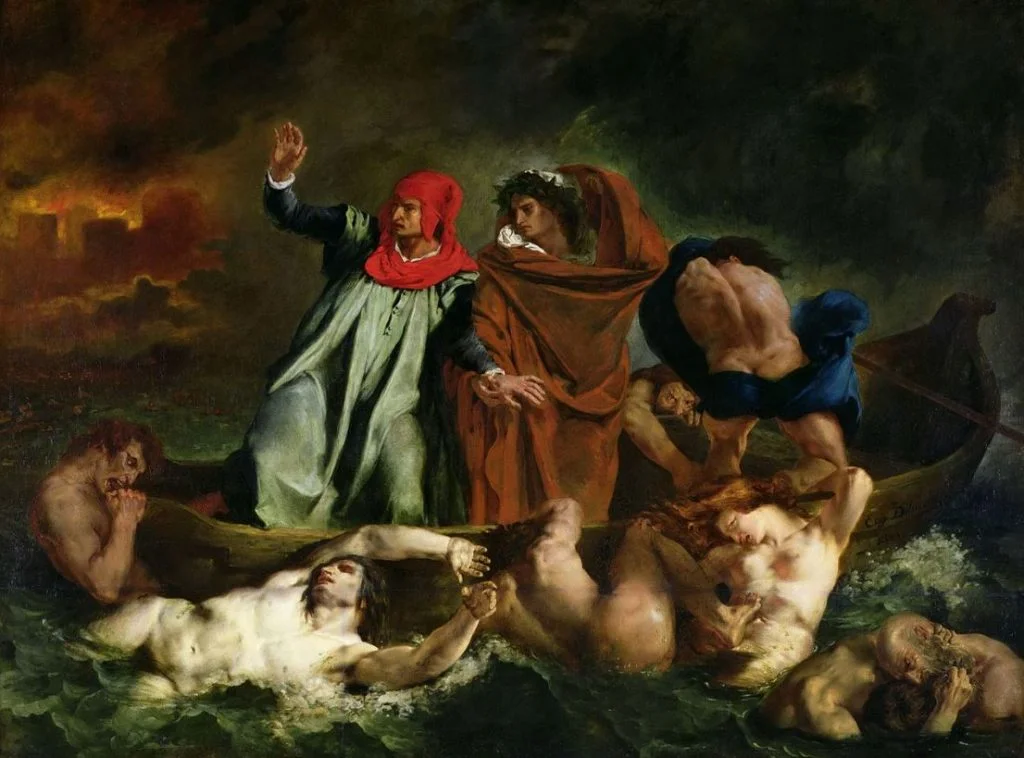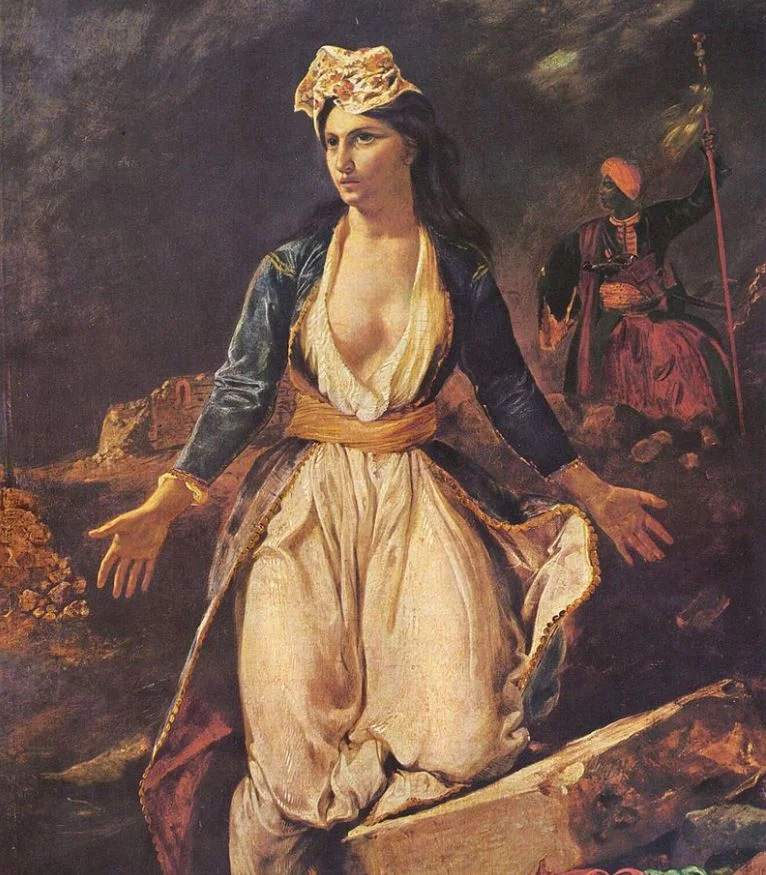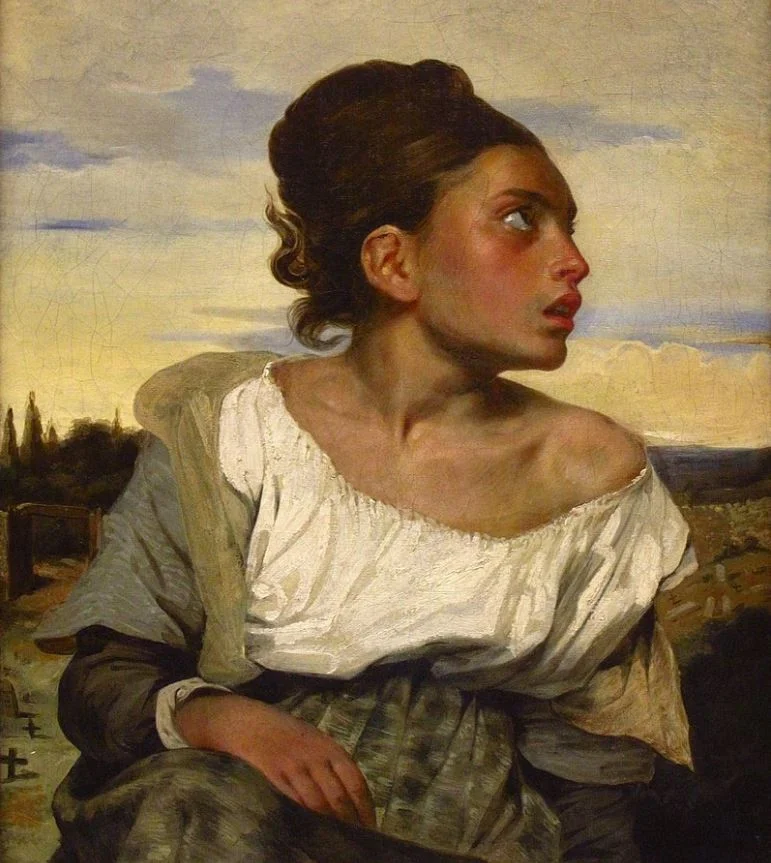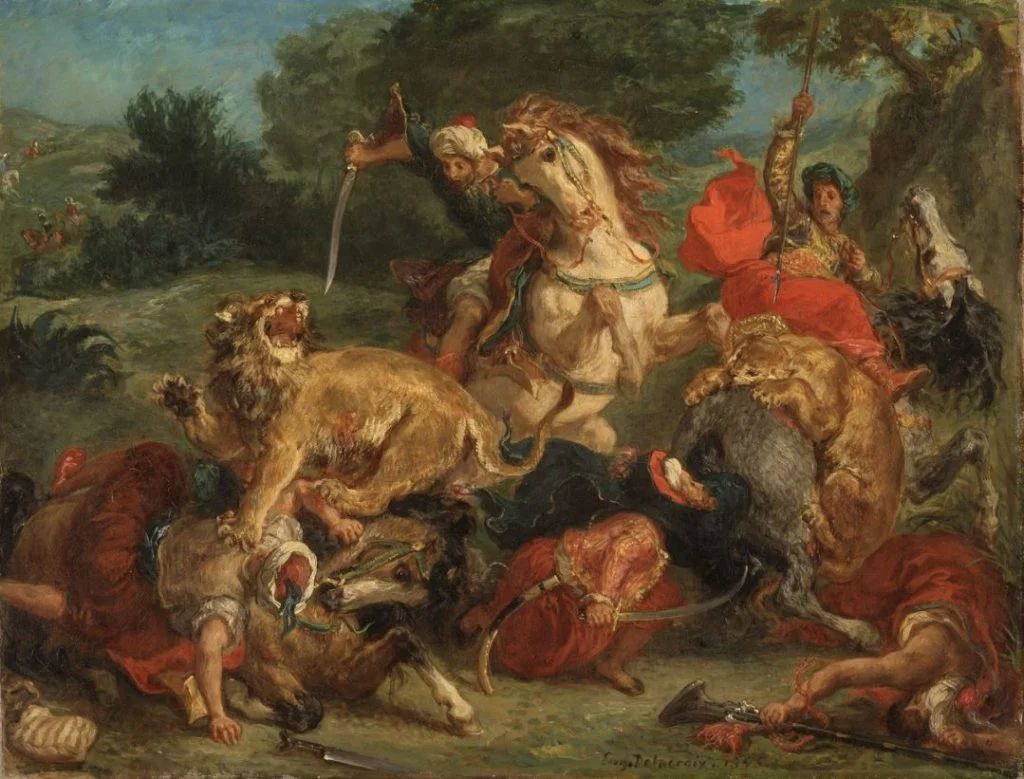When it comes to members of the French Romantic School, there’s hardly any doubt as to who was the most prominent artist. Eugène Delacroix (1798-1863) was influenced by some of the most famous Baroque artists, mainly the works of Peter Paul Rubens. This inspiration added to the dramatic use of color in the most famous Eugène Delacroix paintings.
The Renaissance artists of the Venetian School also formed a crucial source of inspiration for this Romantic artist. This mainly included the works of Paolo Veronese, the ultimate colorist master, and Tintoretto. This was in sheer contrast with the classical themes of his main rival at the time, Jean-Auguste-Dominique Ingres.
In this post, you’ll discover some of the most famous artworks by Eugène Delacroix, one of the most renowned artists of the 19th century!
1. Liberty Leading the People
- Date Created: 1830
- Dimensions: 260 × 325 centimeters (102.4 × 128.0 inches)
- Location: Louvre Museum, Paris, France
La Liberté guidant le peuple or “Liberty Leading the People” is arguably the most famous painting that Eugène Delacroix ever painted.
It was commissioned to commemorate the French Revolution in July 1830, an event that resulted in the monarchy of King Charles X of France being overthrown. It depicts the symbol of liberty who is holding the tricolor flag in one hand and a musket in the other.

2. The Massacre at Chios
- Date Created: 1824
- Dimensions: 419 × 354 centimeters (164 × 139 inches)
- Location: Louvre Museum, Paris, France
The Massacre at Chios was only the second painting in the oeuvre of Delacroix and depicts a horrible scene during the Massacre of Chios in 1822.
This event saw tens of thousands of Greeks slaughtered on the Island of Chios during the Greek War of Independence with the Ottoman Empire. This painting pretty much launched his career as it was displayed at the Paris Salon of 1824.

3. The Barque of Dante
- Date Created: 1822
- Dimensions: 189 × 246 centimeters (74 × 95 inches)
- Location: Louvre Museum, Paris, France
The Barque of Dante was the first major painting of Eugène Delacroix, and even though his real breakthrough came about in 1824, this painting was also displayed at the Paris Salon in 1822.
This Paris is considered to be a turning point in the World of art as it represents a shift from Classical paintings to Romantic themes in art. This also meant that it received quite some contradicting reactions initially.

4. The Death of Sardanapalus
- Date Created: 1827
- Dimensions: 392 × 496 centimeters (154 × 195 inches)
- Location: Louvre Museum, Paris, France
The Death of Sardanapalus depicts a story historical library of ancient Greek historian Diodorus Siculus about Sardanapalus, a man who was presumably the last king of Assyria.
The main painting was inspired by a play written by Lord Byron and was finished in 1827. The artist also created a replica of this painting in 1844. The smaller painting can be found at the Philadelphia Museum of Art.

5. Greece on the Ruins of Missolonghi
- Date Created: 1826
- Dimensions: 208 × 147 centimeters (82 × 58 inches)
- Location: Musée des Beaux-Arts de Bordeaux
Greece on the Ruins of Missolonghi is another painting that was inspired by the Greek War of Independence. This time the event was the Third Siege of Missolonghi by the Ottoman forces in 1825 and 1826.
When the Greeks tried to break out of the city in an attempt to end the siege and escape famine and disease, they were again slaughtered by the Ottoman army. The woman in the painting represents Greece.

6. The Abduction of Rebecca
- Date Created: 1846
- Dimensions: 100.3 × 81.9 centimeters (39.5 × 32.2 inches)
- Location: Metropolitan Museum of Art, New York City, United States
The Abduction of Rebecca is another oil painting by Delcroix that depicts a scene in a novel, this time the abduction of the Jewish Heroine Rebecca in Sir Walter Scott’s novel Ivanhoe.
It’s another painting that was on public display at the Paris Salon, this time in 1846 at the height of the Romantic Period. It’s currently on public display at the MET Museum in New York City.

7. Women of Algiers
- Date Created: 1834
- Dimensions: 180 × 229 centimeters (70.8 x 90.1 inches)
- Location: Louvre Museum, Paris, France
Women of Algiers in their Apartment is a remarkable painting in many ways. It’s one of the few paintings created about women in Algeria because of the strict Muslim rules.
It’s also one of two paintings depicting 4 Algerian women in their apartment, the second one dates back to 1849. These paintings have inspired multiple famous artists in the future, including Vincent van Gogh, Paul Gauguin, and Pablo Picasso.

8. Orphan Girl at the Cemetery
- Date Created: 1823-1824
- Dimensions: 66 × 54 centimeters (26 × 21 inches)
- Location: Louvre Museum, Paris, France
The Orphan Girl at the Cemetery is believed to have been a study for the much larger work called The Massacre at Chios but has become one of the most famous Eugène Delacroix paintings by itself.
The girl literally breathes fear and tragedy, something the artist perfectly depicted in his later work as well. It’s one of the most remarkable works of art depicting extreme emotion in history.

9. Portrait of Frédéric Chopin and George Sand
- Date Created: 1838
- Dimensions: 46 x 38 centimeters (18.11 x 14.96 inches) and 79 x 57 centimeters (31.10 x 22.44 inches)
- Location: Louvre Museum, Paris, France, and Ordrupgaard Museum, Copenhagen, Denmark
The Portrait of Frédéric Chopin and George Sand was originally a double portrait but ended up being cut in two and sold as separate paintings.
It depicts a good friend of Delacroix, the famous Polish composer Frédéric Chopin, together with his girlfriend at the time, the French novelist Amantine Lucile Aurore Dupin, better known as “George Sand.” It’s one of the paintings that Delacroix held onto until his death.

10. The Lion Hunt
- Date Created: 1855
- Dimensions: 57 × 74 centimeters (22 × 29 inches)
- Location: Nationalmuseum, Stockholm, Sweden
The Lion Hunt is one of the paintings from his hunting series which depicts the hunting of wild animals. He got the inspiration for these colorful and dramatic paintings during his extended trips to North Africa which sparked an increased sense of Orientalism.
He was again found influenced by the works of Peter Paul Rubens and studied animals at the zoo and people in the streets to get additional inspiration.



